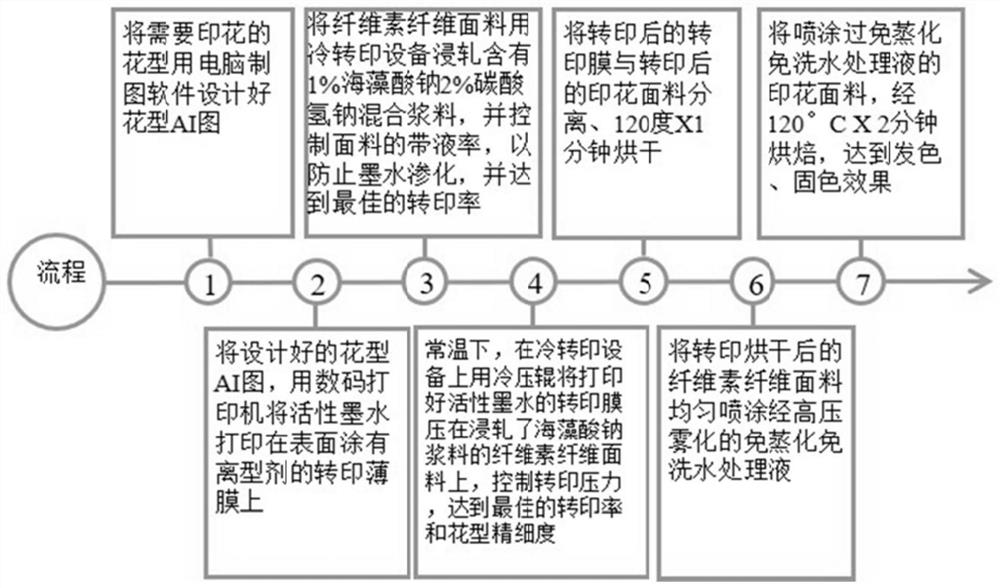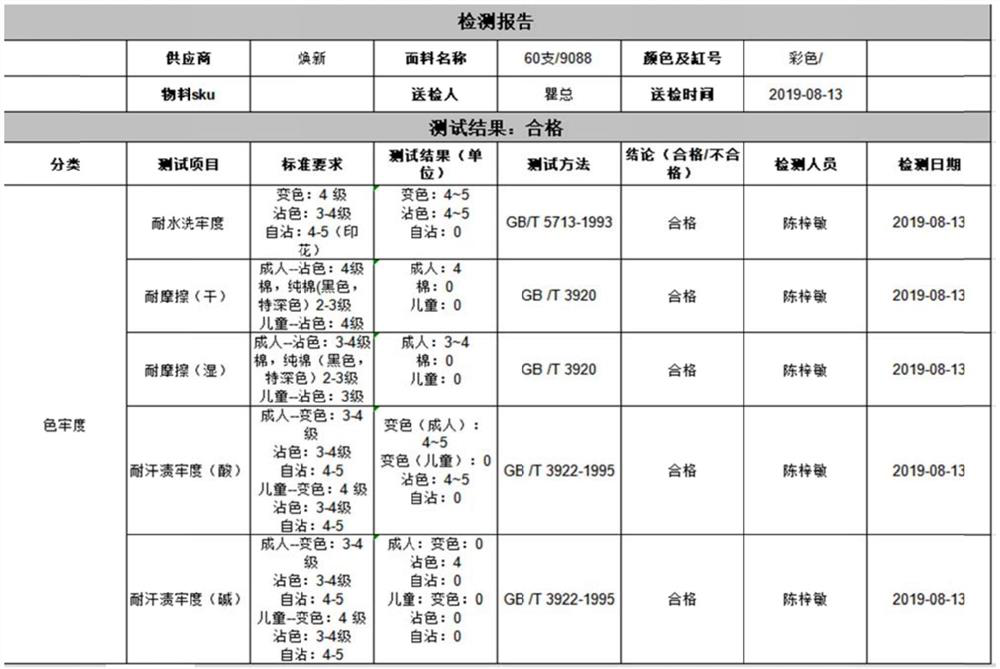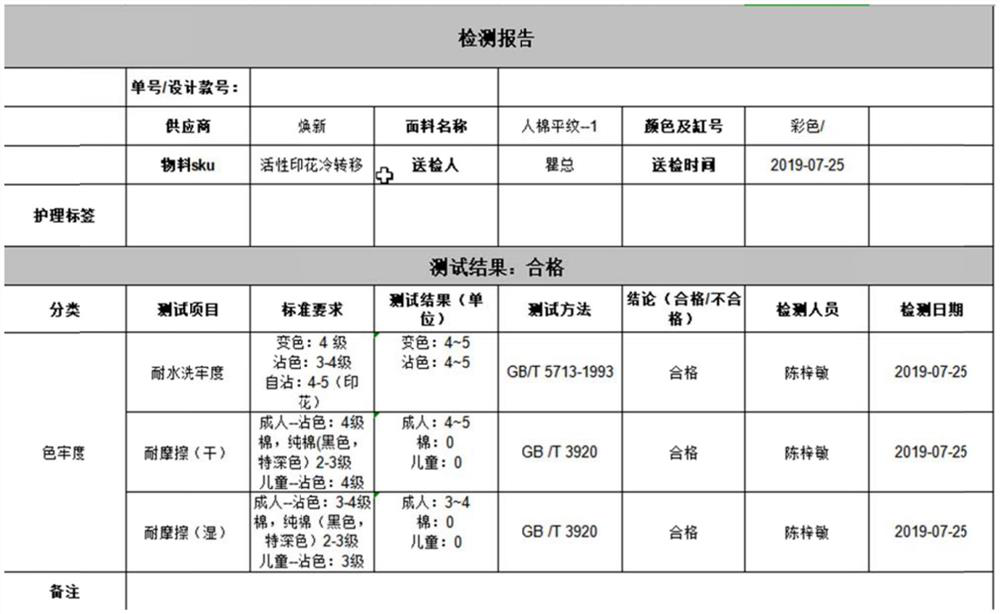A digital active cold transfer printing non-steaming and non-cleaning water additive and method
A technology of water additives and cross-linking agents, applied in transfer printing, printing, dyeing, etc., can solve problems such as low color yield, long production process time, unstable color quality, etc., to improve softness and smoothness The effect of bulkiness, strong sense of color depth and layering, and stable color reproducibility
Active Publication Date: 2022-05-31
广州希音国际进出口有限公司
View PDF7 Cites 0 Cited by
- Summary
- Abstract
- Description
- Claims
- Application Information
AI Technical Summary
Problems solved by technology
[0002] Traditional reactive printing is printed with a screen machine, and the production process is long. It needs color separation and drawing, screen making, paste and color adjustment, on-machine debugging, screen printing, drying, steaming, washing, drying and setting, and a long process flow. , the color yield is low, the color stability is not easy to control, and the consumption of water, electricity, steam, and various additives is large, and a large amount of sewage, waste water, waste, and waste gas are generated at the same time, which pollutes the environment and requires a large amount of Sewage undergoes cumbersome treatment in order to meet national discharge standards
Therefore, traditional reactive printing is a production method with long production time, unstable color quality, high cost, and heavy pollution, which is not suitable for the needs of flexible and fast-reverse production.
[0003] Compared with traditional screen printing, the existing active cold transfer printing has fewer production processes, but it needs to pad the paste of traditional printing before printing, and still needs steaming and washing after printing, which also consumes a lot of water and electricity. , steam, and produce a large amount of sewage, so it cannot replace traditional reactive printing at present, and cannot reach the production process of waterless printing
Disadvantages of traditional reactive screen printing and existing cold transfer printing: the production process is complicated, the production process takes a long time, and the timeliness is poor; steaming and washing are required after reactive printing, which is a necessary production process for traditional reactive printing and reactive cold transfer printing; After steaming and washing water, the color yield is low, the color stability is poor, and the color fastness is poor; the energy consumption of water, electricity, and steam is large, and the discharge of three wastes is large, which is easy to pollute the environment; the production cost is high; it is not suitable for flexible production; water printing production
[0004] At present, there are not many reactive cold transfer printing methods in the industry. The main reason is that reactive cold transfer printing still needs the traditional sizing, steaming, and washing processes, which cannot avoid the color development, color fixing, and lifting of steaming and washing. For the production process of color fastness, the existing technology cannot use non-steaming and non-washing water, because it does not meet the national standard color fastness requirements, and because a large amount of printing paste is added, the handle is hard, and it must be steamed and washed. Only by washing with water can the color fastness and handle be improved
Method used
the structure of the environmentally friendly knitted fabric provided by the present invention; figure 2 Flow chart of the yarn wrapping machine for environmentally friendly knitted fabrics and storage devices; image 3 Is the parameter map of the yarn covering machine
View moreImage
Smart Image Click on the blue labels to locate them in the text.
Smart ImageViewing Examples
Examples
Experimental program
Comparison scheme
Effect test
Embodiment 1
Embodiment 2
Embodiment 3
the structure of the environmentally friendly knitted fabric provided by the present invention; figure 2 Flow chart of the yarn wrapping machine for environmentally friendly knitted fabrics and storage devices; image 3 Is the parameter map of the yarn covering machine
Login to View More PUM
 Login to View More
Login to View More Abstract
The invention discloses a non-steaming and non-cleaning water additive for the first time, the main component of which is the polycondensation product of polyfunctional cross-linking reactive polycondensate and cationic quaternary ammonium salt polymer, including diethylenetriamine and epichlorohydrin Polycondensate, a polymer of dimethyldiallyl ammonium chloride and a crosslinking agent, and a polycondensate of a low-temperature self-crosslinking accelerator. The use of this additive can realize the combination of digital cold transfer printing and non-steaming and non-washing water additives, which is flexible, fast-reversing, energy-saving and environmentally friendly waterless printing production, that is, the number of meters of printing transfer film required for flexible printing by digital printers , high-precision and high-uniformity transfer printing technology, and quick-reverse production with a short process of no-steaming and no-cleaning water, realizing the rapid production process of reactive dye waterless printing. This printing process is the first printing method in the printing industry.
Description
A kind of digital active cold transfer printing no-steaming no-wash water auxiliary and method technical field The invention belongs to the technical field of printing technology, more specifically, relate to a kind of digital active cold transfer printing steam-free Disposable water auxiliaries and methods. Background technique Traditional reactive printing is printed with a screen machine, and the production process is long, and requires color separation and sketching, screen making, sizing and color mixing, and machine loading. Debugging, screen printing, drying, steaming, washing, drying and shaping, the process is long, the color yield is low, and the color stability is not easy to control, and In addition, the consumption of water, electricity, steam and various additives is large, and a large amount of sewage, waste water, waste and waste gas are generated at the same time, which pollutes the environment. It is necessary to carry out cumbersome treatment of a ...
Claims
the structure of the environmentally friendly knitted fabric provided by the present invention; figure 2 Flow chart of the yarn wrapping machine for environmentally friendly knitted fabrics and storage devices; image 3 Is the parameter map of the yarn covering machine
Login to View More Application Information
Patent Timeline
 Login to View More
Login to View More Patent Type & Authority Patents(China)
IPC IPC(8): D06P1/38D06P1/52D06P5/24D06P5/30
CPCD06P1/38D06P1/5264D06P1/5242D06P5/003D06P5/30
Inventor 瞿新楼
Owner 广州希音国际进出口有限公司
Features
- R&D
- Intellectual Property
- Life Sciences
- Materials
- Tech Scout
Why Patsnap Eureka
- Unparalleled Data Quality
- Higher Quality Content
- 60% Fewer Hallucinations
Social media
Patsnap Eureka Blog
Learn More Browse by: Latest US Patents, China's latest patents, Technical Efficacy Thesaurus, Application Domain, Technology Topic, Popular Technical Reports.
© 2025 PatSnap. All rights reserved.Legal|Privacy policy|Modern Slavery Act Transparency Statement|Sitemap|About US| Contact US: help@patsnap.com



